|
Pivotal Pro Football Moments
pivotal NFL postseason moment: A decision by a coach or an action by a player that establishes, continues or changes the momentum of a playoff game.
Dolphins Dominate and Survive Dumb Play
Super Bowl VII: Miami Dolphins vs Washington Redskins
Everyone expected a low-scoring game when the leading teams in the American and National Conferences in points allowed clashed. And that's what they got – a game that remained the lowest-scoring Super Bowl until 2019.
Neither team came close to scoring on their first two possessions. That's when Mike Bragg punted for Washington, and Bob Brunet hit receiver Jake Scott just after he caught the ball. The ball squirted loose, but Dick Anderson recovered for Miami at their 37.
Washington coach George Allen said, "That was the biggest play of the first half. If we'd gotten that ball – and I feel we would have scored – we could have gone ahead, and it would have been a different ball game."
Dolphins Strike First
Instead, the Dolphins embarked on the first scoring drive of the game. After two runs gained a first down, QB Bob Griese dropped back quickly and hit WR Paul Warfield at the left sideline between the cornerback and safety for 19y to the 34. On third-and-four at the 28, Griese dropped back and saw double coverage on Warfield on the left but only CB Pat Fischer on Howard Twilley on the right. Bob threw over leaping LB Harold McLintock, hitting Twilley in stride at the six. Fischer recovered to make the tackle at the three, but Twilley fell into the end zone just inside the pylon. Dolphins 7 Redskins 0 with one second left in the first quarter.
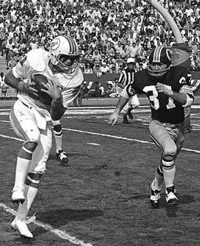 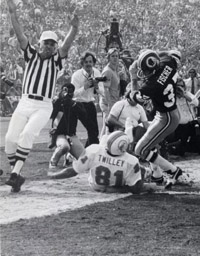 Howard Twilley catches pass in front of Pat Fischer and falls just inside pylon. The touchdown came about as a result of a conversation between Twilley and Griese the week before. The Dolphins had a tendency to run down-and-in routes in opponents' territory. But Twilley knew that Fischer would discover that from film study. So Howard suggested breaking the pattern and instead running a down-in-and-out instead. He and Bob stayed after practice to perfect the maneuver.
Griese: "It was third and four on the 28. Normally, we'll throw to a back in that situation. The way George Allen studies, we knew he would be aware of our tendencies. Since it was our first 3rd-and-four situation, I felt they would likely be in man-to-man coverage. I had both wide receivers go down and in. They had double coverage on Paul Warfield, and that left Pat Fischer one-on-one on Twilley. That was the ideal time to go for the big one."
Twilley: "I had to sell Pat on the pattern. We have had a lot of success on quick down-and-in routes, and I figured Pat thought I would go that way. When I fake that and go out, I usually give the cornerback a little head fake, then break to the outside. This time, though, Howard ran a quick three-step turn in on Fischer, and Pat bought it. Then the receiver cut back outside."
Dolphins Double Their Lead
The next score also came right at the end of a quarter. Washington finally penetrated Miami territory-but only by 1y- at the two-minute warning before halftime. Redskins QB Billy Kilmer threw down the middle. With two receivers not looking back for the ball, MLB Nick Buoniconti snagged it, cut to his right, and set sail to the 28.
In their film study, Miami Defensive Coordinator Bill Arnsparger and Buoniconti noticed that the Redskins liked to circle Brown out of the backfield to the middle for a pass. They knew Kilmer would also pay special attention to Matheson. So on this third down play, Arnsparger didn't rush Matheson but instead blitzed Swift up the middle. As soon as the ball was snapped, Buoniconti took a step to his left, away from Brown's expected route. With Swift charging with his arms upraised, Kilmer didn't have time to notice that Nick had reversed course and returned to the middle, where he intercepted the pass in front of Brown. Kilmer: "It was either get sacked or get the ball right out to Larry, and I forced it." Buoniconti: "We were in a 1-coverage, which meant I had the tight end, Jerry Smith. Because Smith was tied up, I was free to react to Kilmer and go with Brown. I should not have been there."
Instead of Washington denting the scoreboard in the last two minutes, the Dolphins had a chance to add to their lead. After two runs gained 5y, the Dolphins faced third down. Like Miami, the Redskins changed linebackers on passing downs, the younger, faster Harold McLinton replacing Myron Pottios in the middle. The Dolphins again sent in Mandich at tight end. With Warfield and Twilley lined up wide left, Griese rolled right and threw to Mandich, who made a diving grab before sliding out of bounds at the two. After Jim Kiick was stopped for 1y, the Dolphins called timeout. Then Griese handed to Jim again, and he followed FB Larry Csonka, all-pro G Larry Little, and RT Norm Evans - 750 pounds of beef - over right guard into the end zone. Dolphins 14 Redskins 0 (0:18)
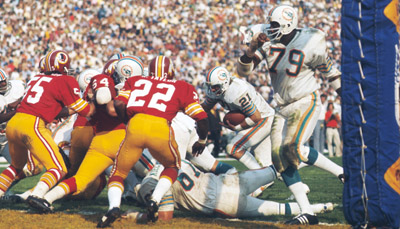 Jim Kiick gains a yard to the one. The Miami defense limited Washington to 49y rushing, 23y passing, and a measly four first downs in the first half. One reason for the failure of the Redskins' rushing attack was their use of the same blocking scheme the Cowboys had deployed in Super Bowl VI. The object was to attack and neutralize MLB Buoniconti. But the 1972 Dolphins Front Four was vastly improved from 1971.
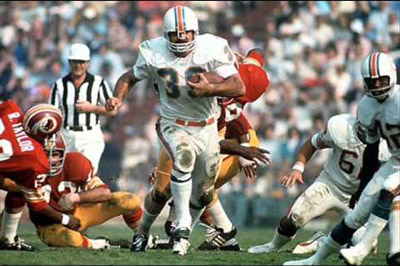 Csonka on the loose. Dolphins Fail to Add to Lead
Late in the scoreless third period, the Dolphins chugged deep into Washington territory, primarily on Csonka's 49y ramble to the 16 – the longest run against the Redskins all year. Two runs later, Miami had 1st-and-goal at the five. At that point, Griese made his only mistake of the day. He dropped back and tried to loop the ball to TE Marv Fleming in the left front corner of the end zone. But DB Brig Owens intercepted the underthrown pass to end the threat.
Shula told Griese as he came to the sidelines, "We had to come out of there with three points." Bob replied, "I know that better than anybody." After the game, Griese explained: "I wanted at least three points because it had been a long drive, and it could have put us into a 17-point lead going into the last period. All I was thinking was 'Don't fumble. Don't throw an interception. Just get the three points.' I saw Fleming break open in the corner of the end zone, and I led him a little to make sure. ... He (Owens) just made a great play on the ball. It was the most upsetting thing about the game."
With Help from Goal Post, Dolphins Repel Redskin Threat
After an exchange of punts into the fourth quarter, the Redskins mounted their best drive of the game. Mixing runs and passes, Kilmer led them from their 11 to the Miami 11. Then Lady Luck intervened for the Dolphins. Kilmer spotted Smith open on a crossing pattern in the back of the end zone. But his pass bounced off the crossbar of the goal post on the goal line.
Smith threw up his arms in frustration, and Kilmer looked to the heavens. Billy afterward: "I tried to throw under Buoniconti's arm. Jerry was open, and I'm sure it would have been a touchdown if it hadn't hit the goalpost."
Needing a touchdown, not a field goal, Billy went to the air again but with dire consequences. He saw WR Charlie Taylor breaking away from Mumphord over the middle from the right, but S Scott stepped in to snag the pass under the goal post and take off down the left sideline. Momentarily, it looked like a 105y interception return, but Harraway caught him at the Washington 48 with 5:08 remaining. The frustrated Redskins had succeeded only in running 7:18 off the clock.
Kilmer: "I just tried to force it in there, and Scott jumped in front of Taylor. It's a bad thing to try to force it."
Scott: "I had rotated out of the zone, and the ball hit me right in the chest."
 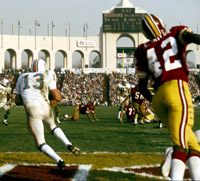 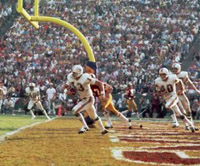 Jake Scott runs interception out of end zone. Redskins Get Late Christmas Present
The Dolphins gained one first down but soon faced fourth-and-six at the Washington 32. So Garo Yepremian came in for a 42y field goal try. He had gone 4 of 11 in the 40-49y range during the season.
Fans headed for the exits in droves to beat the famous Los Angeles traffic. Miami owner Joe Robbie instructed his media spokesmen to send a message to the horde of writers deciding how to start their stories. The field goal would make the score 17-0 to end the Dolphins' 17-0 season. What beautiful symmetry!
Backup QB Earl Morrall had the same thought as he jogged onto the field to hold for the kick. "All our numbers are coming together," he thought.
But on the Miami sideline, Jim Del Gaizo, the third string quarterback, looked at the 14-0 score and the time remaining and wondered: "Why even try this? We don't need the points. They haven't dented our defense. Nothing good can come out of this. Why take the risk?"
Yepremian wasn't thinking about the score or any risks. He simply wanted to make the field goal. In pregame warmups, he had been striking the ball high, which sent it in a lower trajectory than he wanted. He couldn't figure out why that was happening. "Am I holding the ball right?" Morrall had asked. "It's not you," Garo replied. Finally given a chance in the game, he went through his usual routine, said a quick prayer, visualized his technique, checked the wind, marked off his steps, and took his stance. He nodded as Morrall looked back to see if he was ready.
If Don Shula knew how much George Allen emphasized the kicking game, he might not have gone for the field goal. Allen was one of the first coaches to emphasize special teams – a term he coined. He hired Marv Levy to specialize in that area and devoted a lot of practice time to special teams. Several players, like Bob Brunet, were kept on the roster because they were excellent on special teams. Mike Bass recalled: "We studied lots of films (of Miami), and Marv felt there might be an opportunity right up the middle. I was called the Spy Man, as my duties were to ensure any fakes were not successful. Also, I had scored on blocked field goals before."
What happened next was perhaps the most bizarre play in Super Bowl history. The snap was low but OK; the hold was fine. But the kick sailed too low, as Garo feared, and hit Bob Heinz, a defensive tackle blocking in the middle of the line, in the back. The ball bounced on the ground twice before Garo grabbed it running to his right. Instead of going down, he tried to a throw a pass – to whom nobody knows – but lost control of the ball as his arm came forward. The pigskin blooped into the air over his head. As it came down in front of him, he hit it with two hands like a volleyball player returning a serve. But all that did was deflect the ball into the hands of Mike Bass, who took off down the left sideline untouched to the end zone for a 49y fumble recovery touchdown. Knight's PAT cut the Miami lead in half. Lady Luck had deprived Washington of a touchdown when the pass hit the goal post. Now she made amends with this "kooky play" (as announcer Curt Gowdy described it). Dolphins 14 Redskins 7 (2:07) View a video of the blocked FG play ...
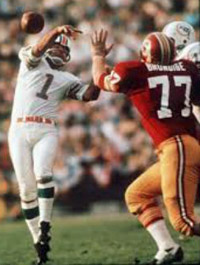 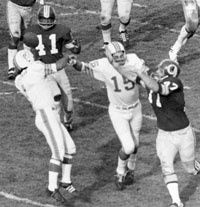 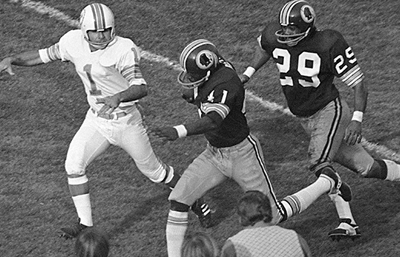 Mike Bass (41) intercepts Ypremian's "pass" and returns for a touchdown. The day before, Yepremian had thrown passes to David Shula, son of the head coach. That was a frequent routine after practice to relax before games. "He was running patterns, and I was throwing it 25, 30 yards. I was confident I could throw," said Garo.
When Garo retrieved the blocked kick, he thought he saw a Dolphin jersey in the flat. Figuring it was Larry Csonka, whose assignment was to run to that area on a busted field goal, the little kicker from Cyprus tried to throw the ball. "I figured I'd throw it forward yet incomplete. Then no problem." But the ball slipped out of his hand. Morrall was trying to block the charging DT Bob Brundige. As the ball came back to him, Garo tried to bat it out of bounds. Instead, he patty-caked it back into the air.
Ironically, Bass and Yepremian were friends from their days together on Detroit's taxi squad. When Mike grabbed the ball, Brundige and Morrall switched roles, Bill cutting down Morrall. As Brundige tells it, he didn't actually throw a block. "I run in front of Morrall and fall down, and he falls over me. Hell, it was 80-comething degrees, and I was worn out."
Garo had an angle on Bass to shove him out of bounds, but he wasn't fast enough to make that happen. Bass had one thought in mind. "No way am I going to let a kicker tackle me. Besides, I'd seen Garo run when we were on the same taxi squad in Detroit. I knew he couldn't run."
Csonka, who was blocking on the right side of the line, recalled: "I had no clue the ball was blocked. There is supposed to be a fire call. The other thing that is supposed to happen is that whoever recovers it is supposed to simply fall on it. You don't try to advance it under any circumstances. That was rehearsed if not talked about hundreds if not thousands of times."
Yepremian returned to the sideline to face enraged teammates. To avoid Shula, Garo went to the end of the bench and sat next to Fernandez. But Manny wasn't sympathetic. "You little *&^%$. We lose this game, I'm gonna break your *&^%$ neck!"
Buoniconti conveyed the same message. "We lose this game, I'm gonna kill you! I'll hang you up by one of your ties – a reference to Garo's off-season job as a necktie salesman.
G Bob Kuechenberg said, "Had we lost, his carcass would not have arrived with the rest of the team. It would have arrived in the baggage department on ice."
DE Bill Stanfill, a Georgia native, said in his Southern drawl that he and his teammates were fixin' to form a lynch mob.
Coach Shula remained calm. He walked over and told his kicker, "Next time, just fall on it."
OT Norm Evans conveyed a positive message. "Garo, don't worry about it. God loves you, and our defense will stop them."
As the game resumed, Yepremian prayed. "Dear God, don't let us lose this way."
On the Washington sideline, Allen yelled, "We got a lotta time, a lotta time left!"
Dolphins Defense Seals the Victory
With three timeouts left, Allen surprised many by not calling for an onside kick. Morris took the ball at the one and returned to the 16. The Miami offense took the field with just a one-score lead.
Shula recalled: "There was now pressure back on the offense, whereas before we had it all pretty much under control. Their offense wasn't doing anything against our defense. But when it is 14-7, any slight mistake by the offense, a fua short gamble, this game could change in a hurry. So the pressure was back on us, and I didn't appreciate that. We had played the whole game so we could be in this situation. So I was real ticked off at Garo as well."
Miami gained one first down on an out pattern from Griese to Warfield. Then Washington used each of their timeouts after the next three plays – all runs.
The Redskins got the ball back after a punt to their 30 with 1:14 to go. But with the entire world knowing he had to pass, Kilmer threw two incompletions, then tossed to Brown in the flat for a short gain before being sacked to end the game.
FINAL SCORE: DOLPHINS 14 REDSKINS 7
References: "17-0-0," Tex Maule, Sports Illustrated, January 22, 1973 "Sports of the Times; Recalling Those 17-0 Miami Dolphins and, of Course, the Alligator," Dave Anderson, New York Times, November 16, 1997 Still Perfect! The Untold Story of the 1972 Miami Dolphins, Dave Hyde (2002) The Football Game I'll Never Forget: 100 NFL Stars' Stories, as told to the editors of Football Digest (2004) "Super Bowl VII: A bad scene," The Washington Times, September 3, 2007 The Ultimate Super Bowl Book, Bob McGinn (2009) 50 Years, 50 Moments: The Most Unforgettable Plays in Super Bowl History, Jerry Rice and Randy O. Williams (2015) |